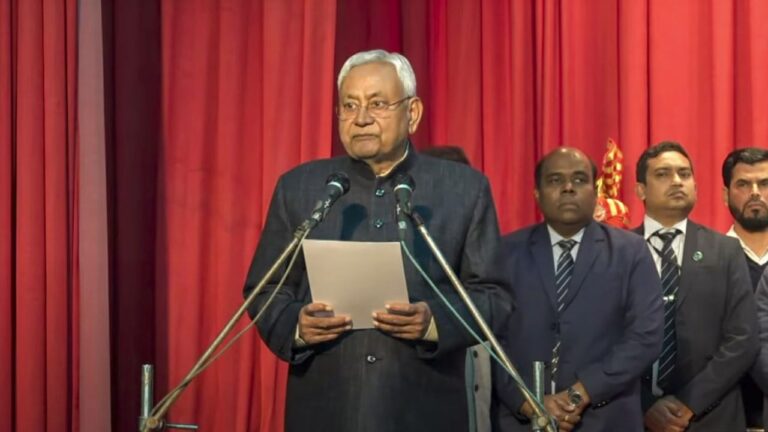News Desk, Kolkata : On Sunday, January 28, like clockwork, Nitish Kumar took oath as the Chief Minister of Bihar for the ninth time, cementing his political prowess in the state. This time around, he assumed the role under the banner of the NDA coalition. Earlier in the day, the JD(U) chief resigned as the Chief Minister of the Grand Alliance government. Within a few hours, backed by the support of 128 MLAs, he staked his claim to form the government to the Governor and subsequently took the oath.
As Nitish Kumar recited the oath in the Bihar Raj Bhavan, the atmosphere resonated with chants of “Modi Modi.” Alongside him, representing the BJP, Smriti Irani’s confidant, Vijay Kumar Chaudhary, also took the oath as a cabinet minister. Speculations suggest that he might be appointed as the Deputy Chief Minister. In this political reshuffle in Bihar, notable figures like BJP’s Vijay Kumar Sinha, Dr. Prem Kumar, JD(U)’s Vijendra Prasad Yadav, Vijay Kumar Chaudhary, Shrawan Kumar, and Hindustani Awam Morcha’s president Dr. Santosh Kumar Sumant also assumed ministerial responsibilities.
However, the highlight of the event was the presence of J.P. Nadda, the national president of the BJP, who graced the oath-taking ceremony. His presence underscored the significance of the political shift in Bihar. Chirag Paswan, the leader of the Lok Janshakti Party (LJP) – a key player in the NDA – was also in attendance, marking a symbolic reconciliation. During the last elections, Chirag Paswan had vehemently opposed Nitish Kumar, even fielding candidates against JD(U) in certain constituencies. However, with the change in political dynamics, Chirag Paswan, after a brief hiatus, returned to the NDA fold.
This political realignment in Bihar witnessed several leaders from different parties taking on new roles in the government. In addition to Smriti Irani’s aide Vijay Kumar Chaudhary, BJP’s Vijay Kumar Sinha, who emerged victorious in the elections, assumed a ministerial position. Dr. Prem Kumar, Shrawan Kumar, and Santosh Kumar Sumant also joined the cabinet. This marks a significant shift in the political landscape of Bihar.
Post the political turmoil, the Congress leadership expressed discontent with Nitish Kumar, labeling him as a turncoat. Mallikarjun Kharge, the Congress party chief, stated, “It is evident that Nitish Kumar’s shift was premeditated. The entire plan of this change was already in place. The India Janta Dal United (JDU) aimed to break the India Alliance and successfully executed this plan. Nitish Kumar left Lalu Yadav in the dark.” On the other hand, T.S. Singh Deo, a Congress leader from Chhattisgarh, commented, “Certainly, Nitish has betrayed us. If being the Chief Minister and working with the BJP was his goal, he could have done it earlier. He had the required numbers to form the government with us. His intention was to present an alternative to the people, but it seems his self-interest takes precedence.”
This political shuffle in Bihar has broader implications for the Indian political landscape, especially in the context of the NDA and its relations with regional allies. The presence of J.P. Nadda at Nitish Kumar’s oath-taking ceremony symbolizes the strengthening of ties within the NDA, emphasizing a unified front. Chirag Paswan’s return to the coalition after a period of opposition showcases the adaptability and dynamics of political alliances in India.
As Bihar undergoes this political transformation, with Nitish Kumar once again at the helm, the narrative extends beyond state politics. It reflects the intricate dance of alliances, power dynamics, and individual ambitions that shape the political narrative of the nation. Nitish Kumar’s political maneuvering, Chirag Paswan’s strategic return, and the BJP’s reinforcement of its alliance with JD(U) paint a vivid picture of the fluid and dynamic nature of Indian politics. As Bihar ushers in this new chapter, it leaves political analysts and observers contemplating the implications of these shifts on the larger canvas of national politics.
DISCLAIMER
Our news media denounces any form of bias and disapproves of sensationalism. The disseminated news is entirely educational and aimed at social awareness. Our media maintains absolute impartiality, adhering solely to the purpose of education and social consciousness.


